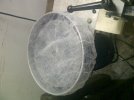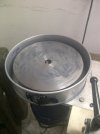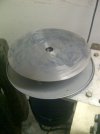- Joined
- Apr 16, 2008
- Messages
- 814
No, that isn't a vertical arbor, that is a horizontal buffer arbor or a jack shaft. It is for running buffers or wheels that give force perpendicular to the shaft. You would want a shaft with bearings to allow thrust parallel to the shaft end ( from the end).
Look at this page and find the AR-16R and AR-17R faceting machine arbors. That is the type made to run a disc or lap that will receive a downward force. The AR-110 and AR-120 are smooth shaft, which is what would work for a disc like Nathan's. I would have to check the bearings they use to see if they are heavy enough for a big steel disc, but this is the type of setup you want to do a VS disc right.
http://www.lapidarydiscount.com/Arbors.html
All that said, 95% of all discs are directly mounted on the motor shaft. From an engineering standpoint it isn't perfect, but form a practical home shop point of view it make good sense.
Will a belt drive introduce any vibration as opposed to direct drive. I have a 3 phase 1 hp motor that could be used but it has a 7/8" shaft.
Also, any disadvantages to the 1degree disc, anything it can't do that a flat disc will?
Thanks Mark
Last edited:



